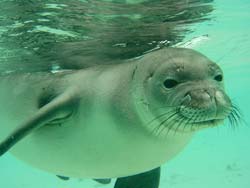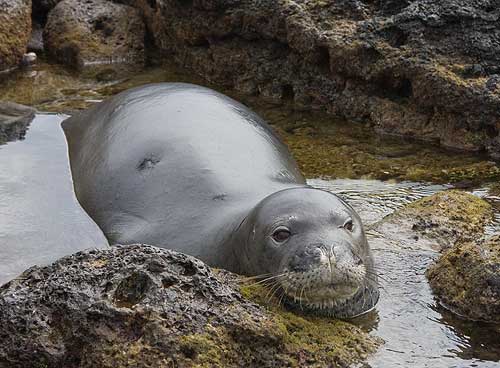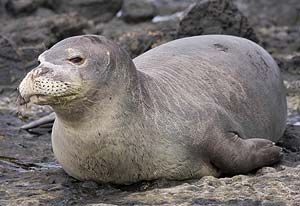An adult monk seal is usually dark grey or brown with a light grey or yellow belly. Adults can weigh anywhere from 396 to 595 pounds; adult females are generally larger than males. Pups usually weigh 24 to 33 pounds at birth and weigh up to 132 to 198 pounds within five to six weeks.
 |
| Hawaiian Monk Seal. (Courtesy NOAA) |
Habitat & Behavior:
Most Hawaiian Monk Seals live in the Northwestern Hawaiian Islands - Kure Atoll, Midway Atoll, Pearl and Hermes Reef, Lisianski Island, Laysan Island, French Frigate Shoals, Gardner Pinnacles, Necker Island, and Nihoa Island. These atolls and islands are very remote and are either uninhabited or have little impact by humans, thus providing an ideal habitat for these easily disturbed creatures.The coral reefs found around these atolls and islands provide the monk seal with its food supply: spiny lobsters, octopuses, eels, and various reef fishes. Their enemies include humans, sharks, diseases, attacks from their own species, and marine debris such as lost fishing nets and plastic products.
Mothers stay with their pups from birth to about five or six weeks, never leaving them unprotected to go feed. During this time, she will lose as much as 300 pounds in weight. When she finally departs, the pup is on its own to learn to catch food.
They spend most of their time in the ocean but like to rest on sandy beaches, and sometimes use beach vegetation as shelter from wind and rain. Monk seals are expert swimmers and divers; one seal was recorded diving into depths in the range of 66 and 96 fathoms (396 to 576 feet). The average monk seal dives 51.2 times per day. The life span of the Hawaiian Monk Seal is from 25-30 years.

Past & Present:
Hawaiian Monk Seals were first recorded in 1825 at the Hawaiian archipelago's northernmost island, Kure Atoll. Scientist estimate about 1,300 to 1,400 monk seals live in the Hawaiian islands chain today. The species has declined at approximately 11% per year since 1989 and is the most endangered U.S. marine mammal.Factors which threathen the persistence and recovery of monk seal populations include disturbance by human activities, interactions with fisheries, mobbing of females by males, and shark predation. Although not directly responsible for monk seal mortality, human activities on beaches, even at low levels, can cause monk seals to abandon haul-out areas. Such disturbance is particularly disruptive to mother-pup pairs.
In the 1800s, shipwrecked crews ate them in order to survive. By the early 1900s, humans were developing commercial and military facilities in monk seal habitat. Bottomfish, longline, and lobster fisheries have all directly affected monk seals. Indirectly, fisheries may affect seals through competition for prey or entanglement in fisheries debris, such as lost or discarded net and line. Mobbing attacks on adult and immature females may be limiting the recovery of the Laysan and Lisianski populations. Attack s by adult males result in known (minimum) deaths of up to 10 or 11 seals annually at Laysan alone, which represents approximately four percent of this island's populations. Monk seals have been found dead with apparent shark-inflicted wounds, and sharks have been observed feeding on dead seals.
Conservation Efforts:
The Hawaiian Monk Seal recovery efforts are overseen by the National Marine Fisheries Service, in cooperation with other government and private organizations and universities. The U.S. Fish and Wildlife Service manages many remote islands as National Wildlife Refuges to protect their habitat.Research includes monitoring monk seal reproduction, survival techniques, and behavior. In the main Hawaiian islands, volunteer groups routinely remove marine debris from the ocean and the beaches; in remote areas, the U.S. Coast Guard and U.S. Navy lend a helping hand.
The Hawaiian Monk Seal was listed as an endangered species in 1976 under the Federal Endangered Species Act. Critical habitat was designated in 1988 from beaches to a depth of 20 fathoms (120 feet) around the northwestern Hawaiian islands.
